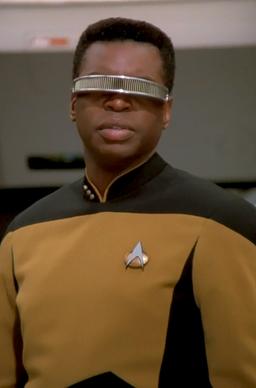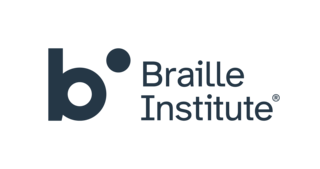
Geordi La Forge is a fictional character who appeared in all seven seasons of the American science fiction television series Star Trek: The Next Generation and its four feature films as well as the third season of Star Trek: Picard. Portrayed by LeVar Burton, he served as helmsman of the USS Enterprise-D in the first season of The Next Generation, then occupied the role of the chief engineer for the rest of the series and in the films before appearing as a commodore in Picard. La Forge has been blind since his birth and uses technological devices that allow him to see – a VISOR in the series and the first film, replaced by ocular prosthetic implants in the last three films and in Picard.

Glasses, also known as eyeglasses or spectacles, are vision eyewear with clear or tinted lenses mounted in a frame that holds them in front of a person's eyes, typically utilizing a bridge over the nose and hinged arms, known as temples or temple pieces, that rest over the ears.

A head-mounted display (HMD) is a display device, worn on the head or as part of a helmet, that has a small display optic in front of one or each eye. An HMD has many uses including gaming, aviation, engineering, and medicine. Virtual reality headsets are HMDs combined with IMUs. There is also an optical head-mounted display (OHMD), which is a wearable display that can reflect projected images and allows a user to see through it.

An active shutter 3D system is a technique of displaying stereoscopic 3D images. It works by only presenting the image intended for the left eye while blocking the right eye's view, then presenting the right-eye image while blocking the left eye, and repeating this so rapidly that the interruptions do not interfere with the perceived fusion of the two images into a single 3D image.

Visual or vision impairment is the partial or total inability of visual perception. For the former and latter case, the terms low vision and blindness respectively are often used. In the absence of treatment such as corrective eyewear, assistive devices, and medical treatment – visual impairment may cause the individual difficulties with normal daily tasks including reading and walking. In addition to the various permanent conditions, fleeting temporary vision impairment, amaurosis fugax, may occur, and may indicate serious medical problems.

A virtual retinal display (VRD), also known as a retinal scan display (RSD) or retinal projector (RP), is a display technology that draws a raster display directly onto the retina of the eye.

The CNIB Foundation is a Canadian charitable organization and volunteer agency dedicated to assisting Canadians who are blind or living with vision loss, and to provide information about vision health for all Canadians. Founded in 1918 as the Canadian National Institute for the Blind to assist soldiers who had been blinded in the First World War, CNIB originally offered sheltered care and specialized employment to people with vision loss. It has since expanded to include other programs and services, including research, public education, rehabilitation counselling and training, advocacy and an alternative-format library for people living with a print disability. It is a member of the Braille Authority of North America.
JORDY or Joint Optical Reflective Display is an optical viewing device developed based on NASA technology. It is used to help the visually impaired see and read.
A visual prosthesis, often referred to as a bionic eye, is an experimental visual device intended to restore functional vision in those with partial or total blindness. Many devices have been developed, usually modeled on the cochlear implant or bionic ear devices, a type of neural prosthesis in use since the mid-1980s. The idea of using electrical current to provide sight dates back to the 18th century, discussed by Benjamin Franklin, Tiberius Cavallo, and Charles LeRoy.
Braille technology is assistive technology which allows blind or visually impaired people to read, write, or manipulate braille electronically. This technology allows users to do common tasks such as writing, browsing the Internet, typing in Braille and printing in text, engaging in chat, downloading files and music, using electronic mail, burning music, and reading documents. It also allows blind or visually impaired students to complete all assignments in school as the rest of their sighted classmates and allows them to take courses online. It enables professionals to do their jobs and teachers to lecture using hardware and software applications. The advances in Braille technology are meaningful because blind people can access more texts, books, and libraries, and it also facilitates the printing of Braille texts.

The Braille Institute of America (BIA) is a nonprofit organization with headquarters in Los Angeles providing programs, seminars and one-on-one instruction for the visually impaired community in Southern California. Funded almost entirely by private donations, all of the institute's services are provided completely free of charge. The organization has seven regional centers: Anaheim, Coachella Valley, Laguna Hills, Los Angeles, Riverside, San Diego and Santa Barbara, as well as outreach programs at more than 200 locations throughout Southern California. It is a member of the Braille Authority of North America.

The Retina display is a branded series of IPS LCD and OLED displays by Apple Inc. and have a higher pixel density than its traditional displays. Apple has registered the term "Retina" as a trademark with regard to computers and mobile devices with the United States Patent and Trademark Office and Canadian Intellectual Property Office. The applications were approved in 2012 and 2014 respectively. The Canadian application cited a 2010 application in Jamaica.

The Lighthouse of Houston is a private, non-profit education and service center dedicated to assisting blind and visually impaired people in the Houston, Texas metropolitan area to live independently. The Lighthouse serves approximately 9,000 people each year and is a member agency of the United Way of Greater Houston.
Vuzix is an American multinational technology company headquartered in Rochester, New York and founded by Paul Travers in 1997. Vuzix is a supplier of wearable virtual reality and augmented reality display technology. Vuzix manufactures and sells computer display devices and software. Vuzix head-mounted displays are marketed towards mobile and immersive augmented reality applications, such as 3D gaming, manufacturing training, and military tactical equipment. On January 5, 2015, Intel acquired 30% of Vuzix's stock for $24.8 million.
Universal Display Corporation is a developer and manufacturer of organic light emitting diodes (OLED) technologies and materials as well as provider of services to the display and lighting industries. It is also an OLED research company. Founded in 1994, the company currently owns or has exclusive, co-exclusive or sole license rights with respect to more than 3,000 issued and pending patents worldwide for the commercialization of phosphorescent based OLEDs and also flexible, transparent and stacked OLEDs - for both display and lighting applications. Its phosphorescent OLED technologies and materials are licensed and supplied to companies such as Samsung, LG, AU Optronics CMEL, Pioneer, Panasonic Idemitsu OLED lighting and Konica Minolta.
OrCam devices such as OrCam MyEye are portable, artificial vision devices that allow visually impaired people to understand text and identify objects through audio feedback, describing what they are unable to see.
Google Talkback is an accessibility service for the Android operating system that helps blind and visually impaired users to interact with their devices. It uses spoken words, vibration and other audible feedback to allow the user to know what is happening on the screen allowing the user to better interact with their device. The service is pre-installed on many Android devices, and it became part of the Android Accessibility Suite in 2017. According to the Google Play Store, the Android Accessibility Suite has been downloaded over five billion times, including devices that have the suite preinstalled.
ScripTalk is an audible medication label technology designed to give access to individuals who are blind, visually impaired, or print impaired. It consists of a device and a microchip attached to the bottom of a prescription drug bottle. The label information is encoded on a Radio-frequency identification (RFID) electronic label (microchip) using the ScriptAbility software by a pharmacist and placed on the prescription package. ScripTalk prescription labels were introduced in the early 2000s. As of 2020, the technology was applied through the United States and Canada.
Electronic glasses are a form of eyewear that incorporates digital electronics and includes a few different types of devices.
Judy Castle Scott is an advocate and activist known for her work to improve the living conditions of the visually impaired. Blind herself, she worked for several public and private organizations dedicated to the cause, and served as the director of the American Foundation for the Blind, retiring in 2015. Over the course of her career, Scott has been the recipient of various accolades, including being inducted into the Texas Women's Hall of Fame.









